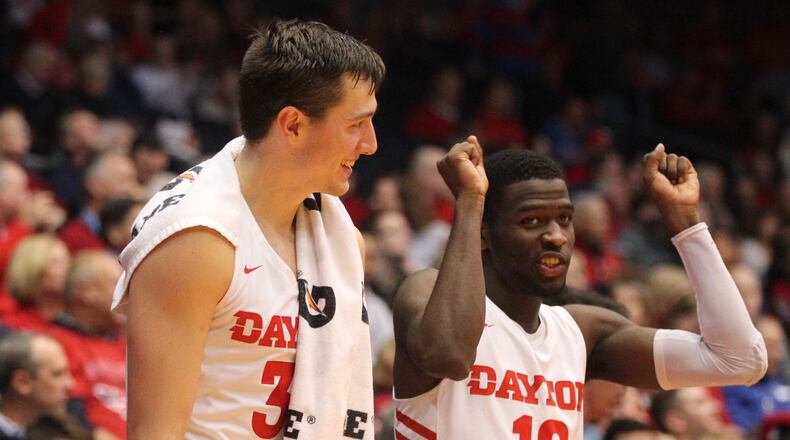Almost everyone outside the Dayton locker room and the UD fan base thinks Anthony Grant’s third team has promise, yet no one has picked it to win the Atlantic 10 Conference championship. Few have picked the Flyers to finish ahead the defending regular-season champion, Virginia Commonwealth, or another veteran team poised for big things, Davidson. The Blue Ribbon College Basketball Yearbook ranked Davidson 17th and VCU 25th in its preseason prediction.
There have been several offseason lists listing the top players in college basketball. Dayton's star player, Obi Toppin, despite ranking among the most efficient scorers in the game last season and becoming the first rookie to make the A-10 first team in 20 years and being touted as a first-round draft pick in 2020, did not make the Athlon Sports College Basketball Preview's top 100. Lindy's Sports ranked him 101st on a list of the top 150.
In short, the experts aren’t ready to predict greatness for a team with so many unknowns. The Flyers would be a top-four A-10 team if they had no significant newcomers. Their championship potential and ability to return to the NCAA tournament for the first time since 2017 depends on the five newcomers, who give Grant and his staff something they didn’t have the last two seasons.
"We've been real thin the past couple of years, and at times our lack of depth caught up to us," Grant told The Athletic earlier this month. "Now we've got some veterans, finally. Hopefully, we're moving in the right direction."
With preseason practice starting Oct. 1, here are five questions the Flyers face entering the new season:
1. Who will start?
Grant has leaned heavily on the returning players in his first two seasons, especially early in the season.
Five returners started in Grant’s first game as head coach against Ball State in 2017. A year ago, four returners and Toppin started the opener against North Florida, but Toppin was only in the starting lineup because one of the returners, Josh Cunningham, was sidelined with a wrist injury. When Cunningham recovered, Toppin went back to the bench before replacing Trey Landers in the lineup later in the season.
» ROSTER PREVIEW: A look at UD’s 11-man team
With that in mind, this could be the lineup on Nov. 9 when Dayton opens the season against Indiana State: junior point guard Jalen Crutcher; Landers, a senior guard; redshirt junior guard Jhery Matos; redshirt senior forward Ryan Mikesell; and Toppin, a redshirt sophomore forward.
There’s one other returner who could replace Matos in that lineup: sophomore guard Dwayne Cohill. Of course, no one will be surprised to see one of the transfers open the season in the starting lineup or earn a starting job early in the season. It’s a guessing game at this point.
2. How deep will the rotation be?
The starting lineup doesn’t matter as much as who’s earning the most minutes. Dayton left two scholarships unfilled, so it has an 11-man roster.
Three starters have averaged more than 30 minutes per game the last two seasons. Reserves did not get many minutes in either season. Dayton ranked 326th in the country in bench minutes (24.4 percent) in the 2017-18 season, when it had 10 scholarship players available, and 336th last season (21.5 percent), when it had eight scholarship players available after Matos suffered a season-ending injury in the sixth game.
» GRANT’S OUTLOOK: UD coach comments on each player
In both those seasons, the bench was even shorter than it looked because there was one freshman who rarely saw action: center Jordan Pierce in 2017-18; and forward Frankie Policelli last season. Pierce now plays at Tennessee-Martin. Policelli transferred to Stony Brook.
It’s hard to say how Grant will distribute minutes this season, but it’s worth looking at how he’s handled his best teams in the past. His third Alabama team, which finished 21-12, ranked 48th in the country in bench minutes (36.4 percent) and used a nine-man rotation in two NCAA tournament games.
Grant’s first NCAA tournament team — his first team at VCU in 2006-07 — ranked 260th in bench minutes (26.7). The Rams returned to the tournament in Grant’s third and final season in 2008-09, and that team ranked 261st in bench minutes (26.9).
3. What newcomer will contribute the most?
Five players on the roster have never worn the red and white for Dayton. Three transfers, all redshirt juniors with two seasons of eligibility remaining, sat on the bench for the entire 2018-19 season and have now been on campus for more than a year: guards Ibi Watson and Rodney Chatman; and center Jordy Tshimanga.
The fourth transfer, redshirt sophomore forward Chase Johnson, arrived at UD in January after leaving the Florida Gators. Johnson appealed to the NCAA in hopes of becoming eligible for the first game and is still waiting for a ruling. If he doesn't win the appeal, he will be eligible to play after the first semester ends, which means he could debut Dec. 14 against Drake.
» LOOKING BACK: Transfers focus on helping team get better
Watson is the newcomer most likely to add the most offensive punch to the team — multiple teammates have praised his shooting accuracy — though he never got a chance to showcase his skills in two seasons at Michigan. He scored a total of 82 points in 45 games and played double-figure minutes only four times in his sophomore seasons.
On the defensive side, expect Chatman to add the most. He’s the most experienced of the transfers, having averaged 32.3 minutes per game as a sophomore at Chattanooga.
Tshimanga will help Dayton on the boards. In two seasons at Nebraska, he grabbed 13.1 rebounds per 40 minutes.
Only one of the newcomers, freshman center Moulaye Sissoko, who arrived on campus in June, wasn’t on the roster last year. He enrolled at UD with the body of a veteran but may have a hard time finding playing time on this deep and experienced team.
4. Will Dayton improve its 3-point shooting?
The NCAA announced in June the 3-point line will move from 20 feet, 9 inches to 22 feet, 1 ¾ inches for the 2019-20 season, matching the international distance. That could be good news for Dayton, which was a below-average 3-point shooting team last season but also shot fewer 3-pointers than most teams.
The Flyers connected on 33.2 percent — a slight step back from their 33.7 percentage in 2017-18 — of their 3-point attempts. The national average was 34.4.
» ATLANTIC 10: Early prediction for next season
Toppin was Dayton's most accurate 3-point shooter (52.4 percent) but took only 21 shots from long range. He said this summer he expects to shoot more from the outside. Crutcher improved his 3-point accuracy from 33.8 as a freshman to 36.3 and led the team in 3-point attempts (70 of 193).
Chatman shot 33.9 percent in his last season on the court, and that was the same percentage Mikesell shot last season.
While becoming a better 3-point shooting team will help Dayton, it’s probably just as important that it keeps doing what it has done best the last two seasons, and that’s being an efficient offensive team inside the arc. Dayton has ranked second in the nation in 2-point percentage the last two seasons with the same accuracy (59.5).
5. Will the Flyers win enough of their key non-conference games?
Dayton's at-large NCAA tournament hopes depend on three games in the Maui Invitational in November and two non-conference games on neutral courts — against Saint Mary's in Phoenix and Colorado in Chicago — in December. If Dayton can win even three of those games and avoid being upset at home in eight non-conference home games, it should be in good shape entering A-10 play. When it made the NCAA tournament as an at-large team four years in a row (2014-17), Dayton lost no more than three games in non-conference play.
» SCHEDULE: Ranking non-conference opponents
The first key game comes against Georgia on Nov. 25 in the first round in Maui. A win there likely will give the Flyers a shot against one of the nation’s top teams, Michigan State, in the semifinals a day later but also will help Dayton avoid a matchup with Division II Chaminade, the host of the tournament, on the final day of the event.
About the Author

